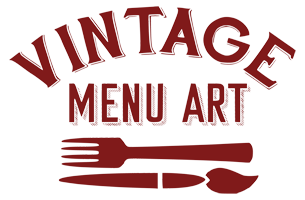Blue Star Inn - 2018 Calendar, February
To look at this menu’s cover, you wouldn’t guess it was for a Chinese restaurant, except for the wording. While many other Chinese restaurant menus offer copious numbers of dragons, pagodas, three-pronged yellow flags and Chinese script, the Blue Star Inn has none of this.

Instead we have a striking art deco-esque building, with a stylized sky behind it – simple, elegant, attractive, and apparently reflective of the establishment itself.
In contrast to many menus in our collection, we know a lot about the Blue Star Inn – thanks mostly to a 2006 undergraduate dissertation by Andy Lui of Oklahoma State University, who interviewed one of its owners, Alan Yee.
This is one of those small stories we find somehow incredibly fascinating – perhaps because the story of the Blue Star Inn can tell us a lot about Midland, about American tastes, and about the global oil market. Sort of.
So, if the tale of a restaurant in a small city in Texas interests you, please do read on…
The Rise and Fall of A Chinese Restaurant
There were no Chinese restaurants in Midland before the Blue Star Inn came along – in fact, it seems like there were precious few restaurants of any kind, despite Midland being first a booming oil town, and later an important military base.
Chinese restaurants had been around in America since the 19th century, and were often renowned for their high standards – but racist attitudes caused them problems. By the mid 20th century the restaurants had evolved to serve a Chinese-American hybrid cuisine, mostly from the Canton region of Southern China, but sweetened and morphed to suit American palettes.
Joe Chung was running the Blue Star Inn in Fort Worth, Texas, when he fell in with Joe Jot, another Chinese chef nearby, and Richard Yee, who had come south from his family restaurant in Minnesota when he realized the market in places like Texas was wide open for Chinese restaurants.
The three men opened up the Blue Star Inn in Midland in 1952 – but not just to serve Chinese food. Unusually, the Inn also offered a full American menu, with steaks, chops, hamburgers and the like – to the point where some people never realized it was a Chinese restaurant.
Creative tension between Yee and Jot on the one hand, who favored focusing on food quality, and Chung on the other, who emphasized service and hospitality, meant the Blue Star Inn excelled in both.
The restaurant was an immediate hit – locals would wait up to 30 minutes for a table, just to try out the new place in town. But when curiosity eventually waned, Chung suggested sacrificing some of the dining area to install a grill, to let chefs cook dishes right in front of the diners – and the Blue Star Inn boomed again.
Chung emerged as the de facto boss thanks to his extensive charm and customer service skills, as well as his abilities as a manager. Smartly dressed, he would welcome customers personally, engage them in conversation, and make sure the waiting staff were well trained and courteous – as well as focusing on smart décor, including a distinctive fish tank.
Little changed at the Blue Star Inn between the 1950s and 1970s, with the owners focusing on internal expansion – eventually building up a staff of around 30.
In 1976 Richard Yee died, leaving his share in the business to his wife, and daughter Betty Yee, which in practice led to his son-in-law Ronny Gee taking on more of the management. Ronny had experience in Chinese restaurants in Canada before he started working at the Inn in 1968.
Then in 1982, Richard Yee’s son, Alan, bought out Chung’s share of the Blue Star Inn for $230,000, and so a new generation took over. Ronny ran the kitchens while Alan looked after the front-of-house.
Unfortunately, the pair took over just as Midland faced a downturn in the oil slump of the early 1980s, combined with a new road system which marginalized the Blue Star Inn’s location. In addition, the Inn was no longer the main game in town; competition was now fierce, and included several of a new generation of Chinese restaurants, which brought more authentic – and novel dishes to Americans.
The next three decades saw the slow decline of the Inn, despite innovations such as a cocktail bar. Over time the staff numbers fell from 30 to around 10, mostly family members – but the restaurant still eked out a small profit, mostly because the partners owned the land and building outright.
But by the late 2000s the restaurant needed significant renovation – and so the owners decided to close down the Inn.
Midlanders still have fond memories of the Blue Star Inn – in a 2010 vote on top Midland landmarks, the Inn was joint top, and commenters shared their stories:
“When you went there for dinner, if your peered through his office window you could see [Joe Chung] reading a newspaper. A newspaper that was printed in Chinese. Pretty exotic stuff for a 6 year-old Midlander.” – DG Heck
“Who knew that Blue Star Inn had Chinese food? We went there for awesome steaks, delicious cinnamon rolls and to watch the fish tank.” – J Mark Lewis
“… boy I hated Chinese food but liked the fish tank.” – David Hastie

